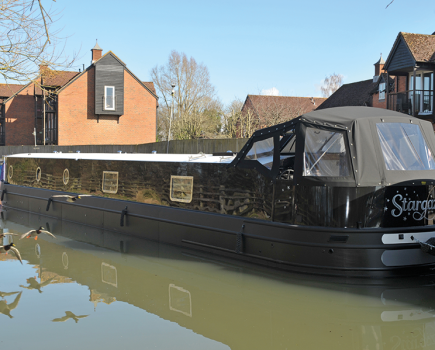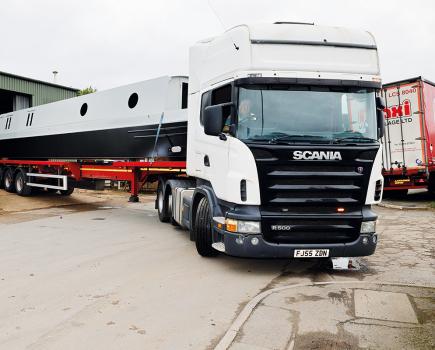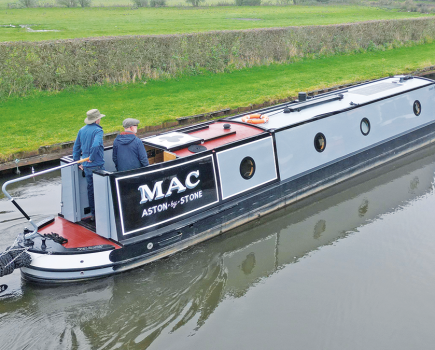Norton Canes Boatbuilders 60ft
NORTON CANES BOATBUILDERS 60ft
Most people buying a new narrowboat put a quiet engine near the top of their wish list. But for others, only a noisy one will do. And when you’ve heard the sound of vintage engines, such as the one in Fenchurch, you understand why.It’s not the volume of the sound that’s appealing, it’s the quality. The slow thump of an old engine is rich and resonant. It’s a sound that is easy to spend all day with and still want to hear again tomorrow; and it’s a sound that will almost certainly attract positive comments from lock partners and passers-by.But just because Fenchurch has an engine dating from the 1960s, don’t imagine the rest of it is old-fashioned. Nothing could be further from the truth. This is a boat with all mod cons, a contemporary interior, and some high-tech electrics, giving the owners, Les and Jill Usher, a boat with the best of both worlds.
EXTERIOR
Fenchurch is a 60ft traditional style boat, built by Graham Edgson and his team at Norton Canes Boat Builders, based at the furthest reaches of the BCN backwaters.Norton Canes has a reputation for the quality of its shells, and it’s quality that is immediately evident. The shape of the boat is just right: the cabin is lower than most modern boats, and its sides slope inwards more steeply, making it easier to walk along the gunwales. At the stern, the cabin curves in, making the gunwales wider and providing more standing room – which is important on a trad-sterned boat.The shape of the bow is a delight. Faithfully reproducing the Josher shape is difficult, but Graham Edgson gets close to the correct curves. Yet he will only ever claim inspiration from Joshers, insisting that the exact shape is only possible on a much deeper draughted boat. There are interesting visual details everywhere, from a chunky boatman’s beam across the roof, to lovely scrolls in the roof rails (but not too many: Graham says that would look over-the-top). The attention to detail extends even to the anti-slip surface on the gunwales: there’s a diamond pattern in the paintwork in front of each side hatch.But perhaps the greatest sign of quality workmanship is the smoothness of the cabin sides. Not only are they ripple free, but it’s virtually impossible to see the welds. We had to look very hard to work out where one sheet of steel finished at the next one started; from a distance, the joins are all but invisible.This was undoubtedly one of the best pieces of steelwork we’ve seen in a very long time, and Graham is reluctant to give away the trade secrets which allow him to achieve such a finish. But it’s clear that time plays a crucial role. A Norton Canes boat isn’t turned out in a few weeks, it takes months. And once the shell is complete, Graham believes in leaving it to rest for a few months so the welds can settle and a layer of rust can form. Then the whole shell is grit-blasted ready for painting.The paintwork itself is another Norton Canes triumph. The work is carried out in a heated wet-dock, where numerous coats of paint are applied, giving a rich, deep finish. In Fenchurch’s case, the green and cream colours help give the boat a solid, traditional feel, and go well with the brass portholes. Towards the stern are red panels carrying the name and number. The signwriting, by Dave Moore, is fresh and lively. The roof is Raddle Red, a matt colour that stops glare from the sun and which Graham says is easily touched up.
SALOON AND DINETTE
While the outside of Fenchurch looks very traditional, the inside has a light, modern look, thanks to the use of white beech throughout. The trim is solid timber, all hand carved and chamfered, while the panels are double-faced block and ply. There’s beech tongue and groove on the ceiling, while the floor is made from solid oak. All the woodwork was varnished (with a matt finish) before being brought onto the boat, so there won’t be any unvarnished lines if there’s some movement.Entry to the saloon from the unusually low well deck is through a pair of half-glazed steel doors. There’s just one step down inside, and the tread lifts to reveal the water pump. On one side of the door is a Franco Belge solid fuel stove, set on a plinth, and with glossy red tiles behind. On the other side there’s a cupboard with an expertly made curved door. In fact, Glynn Walker, who fitted out the boat, says the number of doors is the thing that sticks in his mind about this build: there are dozens of them, thanks to the amount of storage throughout. There are numerous cupboards in the saloon, one of which hides a flat-screen TV that can be swung out and around to face the saloon’s two freestanding arm chairs.The dinette is a space-saving design consisting of a built in seat across the boat, like one half of a Pullman dinette. It’s attractively upholstered, and there are drawers and a space for two folding guest chairs underneath. The table is normally kept folded away, but goes up easily enough. Les and Jill say they designed the boat for just the two of them, but the table is big enough for four. A clever feature is the finrad built into the dinette’s backrest. The heat comes up through a smart grille, a neat way of providing heating without having a radiator on show.Opposite the dinette is a side hatch, complete with a set of ladder-like steps.
GALLEY
The galley is another area with lots of storage – and lots more doors. There’s a wine rack tucked under the gunwale, then the gangway moves from one side of the boat to the centre, with a multitude of little cupboards along the route. There are also doors hiding the integral fridge and the washing machine.The airy feel is enhanced by pale grey granite worktops and a prism in the ceiling that allows light to flood in. There’s a sink on one side, with a tap which includes a filter for drinking water.This is a gas-free boat, so all the cooking is electric. There’s a John Lewis electric oven, and a Bosch two-ring hob. Jill says she practised at home to see how many rings she really needed, and decided two was plenty. Because of the high power consumption, the oven can only be used when the boat is on shore power, or when the generator is running. The Ushers insist they haven’t found this limiting, but we suspect it could be a disadvantage on a long trip.
SHOWER ROOM
This is a well thought out room, with some clever touches. The main feature is a quadrant shower, but there’s no shower tray. Instead, the tiled floor continues inside the shower and Glynn has fabricated a curved lip to stop the water going everywhere. The shower doors fold inwards, so there’s maximum space for drying yourself.The toilet is a macerating system from Lee Sanitation. The holding tank is under the bed, but unfortunately isn’t on the centreline so gives the boat a slight list when it’s full.The calorifier is also in the bathroom – hidden away behind the shower. Access toit is by a door in the main cabin.
CABIN
The cabin is cosy and welcoming, with plenty of storage. There’s a cross-bed with two drawers underneath. The base board is hinged and needs to be flipped open to make the bed. Lifting the mattress out of the way in order to do this could prove tricky, but Jill says they’ve found the process easy. On the opposite side, the bed support contains a finrad.There are cabinets on each side of the bed, both of which are freestanding. One hides the access door for the calorifier. Above the bed is a row of small cupboards and a built-in radio. The Ushers like to listen to Radio Four when they wake up.For hanging clothes there’s a large wardrobe with plenty of space, a mirror on the inside of the door, and a light that comes on automatically when the door is opened.
ENGINE ROOM
Apart from the engine (of which more later), the most noticeable feature of this room is the number of doors. They’re under the gunwales on both sides, hiding fuse boxes, inverters and other electrics. There’s also a full height door in one corner, behind which is a Porta Potti. The Ushers affectionately call it the ‘downstairs loo’. In another corner is a tiny sink with its own tap.The floor, which is painted Raddle Red, lifts in sections to reveal the boat’s bank of batteries, and to provide more storage.It has the feel of a room that invites pottering. Any owner who chooses to have an engine room is likely to be the type who will escape there regularly to do all manner of little jobs. And the beauty is that tending to the batteries or changing the oil can all be done under cover, and in relative comfort. Everything is easily accessible, which is something the owners of cruiser sterns or semi trads could never say.
BACK CABIN
The Ushers wanted a modern take on a back cabin, so this room has the beech fit out found in the rest of the boat. There’s a long bench seat on one side, and a bank of cupboards on the other.As with a traditional back cabin, there’s a drop-down panel that makes a 4ft cross bed for guests. Where a working boat would have had a drop-down table, the Ushers have gone for an alcove, which contains an electric kettle and a set of mugs for easy on-the-move refreshment. And where you might expect to find a boatman’s stove, there’s another modern twist: a heated cupboard. It has a finrad built into the bottom, providing the perfect place to dry wet clothes.As a day cabin, the room works very well. As a guest room, it’s perhaps a little utilitarian (it’s flooring, for example, is the same painted wood as the engine room). It also highlights the one flaw in the layout: guests either have to use the ‘downstairs loo’ in the middle of the night, or climb over the bed in the main cabin to get to the bathroom. A better solution would have been to swap the positions of the main cabin and the bathroom.
TECHNICAL
The engine fitted in Fenchurch is a Gardner 2LW, dating from the 1960s, which has been fully reconditioned by Walsh’s Engineering in Manchester. The 2LW is a 2.8-litre unit that develops 31bhp at 1500rpm – although you’re never likely to use such high revs. Graham and his team make the controls for the engine and fit a PRM gearbox. It’s teamed up with a 22in prop.The engine is mounted on solid hardwood bearers, so there’s no contact between the engine and the steelwork which cuts down on vibration. Graham says the engine isn’t likely to need more maintenance than a modern engine, although any customer who chooses a classic engine is likely to be the type who would enjoy looking after it themselves.The rest of the boat’s systems are rather more up to date. The electrics come from Mastervolt and the DC system is 24 volts rather than the more usual 12, and operates off four 225 AGM gel batteries. There is, though, a converter to take the power down to 12 volts for the car radios on board.Most of the lighting is provided by 24-volt LEDs because they use a fraction of the power of halogen bulbs and produce less heat. However, a stabilised voltage is essential, so there’s another converter fitted.The 240-volt system can make use of a shoreline, or the Mastervolt 2.5kw inverter. There’s an automatic switchover between the two. In addition, there’s a large Whisper 8 generator located in the bow. The builders took great care to make sure that it was accessible, and didn’t prevent access to the bow thruster, which is sited underneath, so it can be unbolted and slid out on runners for general maintenance.The generator has its own diesel tank, which is particularly important now that fuel for propulsion is taxed more heavily. Also located in the same bow locker is the Webasto heating system.Another modern piece of equipment is the hydraulic bow thruster, made by ARS. Rather than a propeller, it uses an Archimedes screw, which is said to provide more power and has the added advantage of mincing anything that gets in its way, rather than becoming clogged. The downside is that it’s rather noisy (and, unlike the engine, not in a good way).
ON THE WATER
To go with the classic engine, Fenchurch has traditional controls. They’re actually very easy to use. A brass grab handle selects the gear: push it forward to go forward, pull it backwards to go into reverse; neutral is midway between. A brass speed wheel controls the throttle via a couple of rods and a simple gearbox attached to the ceiling of the engine room.The throttle takes a little time to respond, but once you’re going the experience is a joy. The boat is heavy and has a slightly deeper draught than most modern boats (about 2ft 3in at the stern). It goes where it’s pointed and doesn’t easily get blown off course. The rudder is a huge piece of 10mm steel, so the tiller feels heavy but it’s very smooth, and because the rudder post is set at an angle the rudder centres itself after each turn.Add the sound of the engine and your time at the tiller will be a pleasure.
CONCLUSIONFenchurch is a boat that’s hard to fault. The shell is superb, with beautiful lines and built with time, care, and attention. The fit-out is high quality and the vintage engine makes it a very special package.But all this comes at a price, and at �179,000 it’s a significant one. One reason the cost is so high is that engine. Its price tag is around double what you’d pay for a modern engine, and it costs more to install. Another is the sheer time it takes to build a shell of this quality, and fit it out to such a high standard; a third is the amount of modern systems hidden underneath the traditional exterior.This is a boat which is bullet-proof as well as beautiful. The shell is a triumph and the Gardner engine will probably go on for ever – and that’s a combination any owner would like the sound of.







